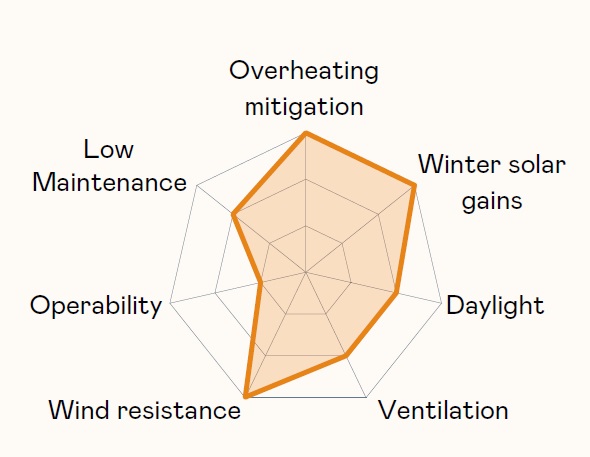External sliding shutters

|

|
Sliding shutters made of waterproof, hardwearing materials attach to tracks fixed to building façades. Like sliding doors, shutters can slide away completely, revealing windows in full. Furthermore, their inherently dynamic nature can enliven a façade’s appearance. When opened, shutters typically stack behind each other, while multiple shutters can be overlapped within the same track to fully shade wider windows.
| Overheating mitigation | High | Blocks most of the solar gains when fully closed. Effective in all orientations |
| Winter solar gains | High | Allows maximum solar gains when fully opened |
| Daylight | Medium | Depends on the free area of the shutters and how much they are closed. In winter allows maximum daylight when fully opened |
| Ventilation | Medium | Allows ventilation, but depends on the free area of the shutters and how much they are closed |
| Wind resistance | High | Robust device fitted within channels |
| Operability | Low | Manually operated that requires leaning out the window. Not suitable for reduced mobility occupants. The performance depends on occupant behaviour |
| Maintenance | Medium | Inspect channels and wheels |
| Cost | ££££ |

|
“ The sliding mechanism of the shutters and their Hanham Hall, South Gloucestershire |
This is an extract from Shading for Housing, Design guide for a changing climate, published by the Good Homes Alliance and the British Blinds and Shutters Association in 2023. You can download the guide in full at: https://bbsa.org.uk/new-design-guide-on-shading-for-housing/
--BBSA
[edit] Related articles
Featured articles and news
RTPI leader to become new CIOB Chief Executive Officer
Dr Victoria Hills MRTPI, FICE to take over after Caroline Gumble’s departure.
Social and affordable housing, a long term plan for delivery
The “Delivering a Decade of Renewal for Social and Affordable Housing” strategy sets out future path.
A change to adoptive architecture
Effects of global weather warming on architectural detailing, material choice and human interaction.
The proposed publicly owned and backed subsidiary of Homes England, to facilitate new homes.
How big is the problem and what can we do to mitigate the effects?
Overheating guidance and tools for building designers
A number of cool guides to help with the heat.
The UK's Modern Industrial Strategy: A 10 year plan
Previous consultation criticism, current key elements and general support with some persisting reservations.
Building Safety Regulator reforms
New roles, new staff and a new fast track service pave the way for a single construction regulator.
Architectural Technologist CPDs and Communications
CIAT CPD… and how you can do it!
Cooling centres and cool spaces
Managing extreme heat in cities by directing the public to places for heat stress relief and water sources.
Winter gardens: A brief history and warm variations
Extending the season with glass in different forms and terms.
Restoring Great Yarmouth's Winter Gardens
Transforming one of the least sustainable constructions imaginable.
Construction Skills Mission Board launch sector drive
Newly formed government and industry collaboration set strategy for recruiting an additional 100,000 construction workers a year.
New Architects Code comes into effect in September 2025
ARB Architects Code of Conduct and Practice available with ongoing consultation regarding guidance.
Welsh Skills Body (Medr) launches ambitious plan
The new skills body brings together funding and regulation of tertiary education and research for the devolved nation.
Paul Gandy FCIOB announced as next CIOB President
Former Tilbury Douglas CEO takes helm.
UK Infrastructure: A 10 Year Strategy. In brief with reactions
With the National Infrastructure and Service Transformation Authority (NISTA).






















